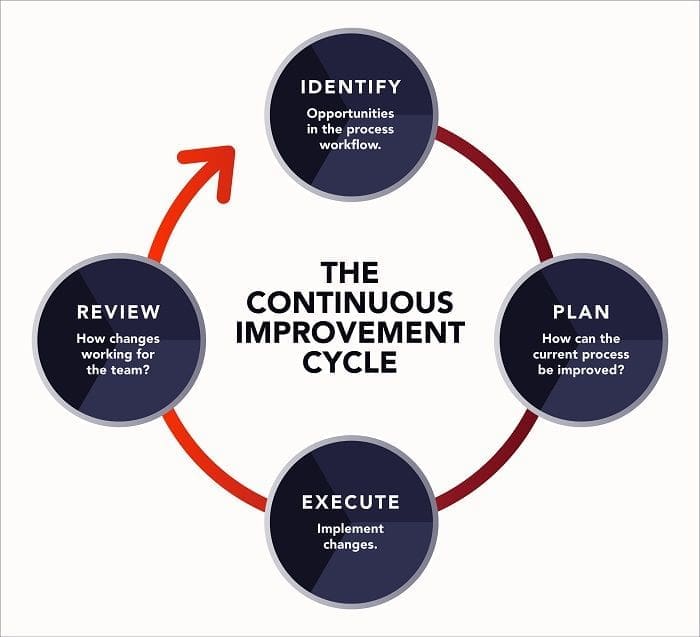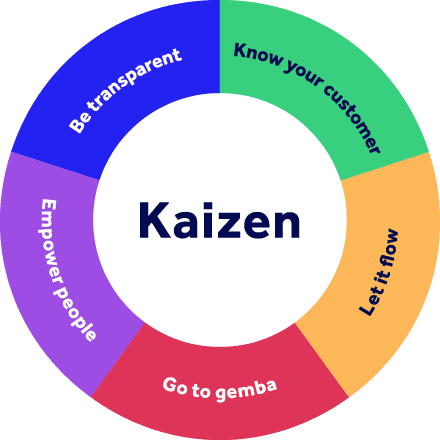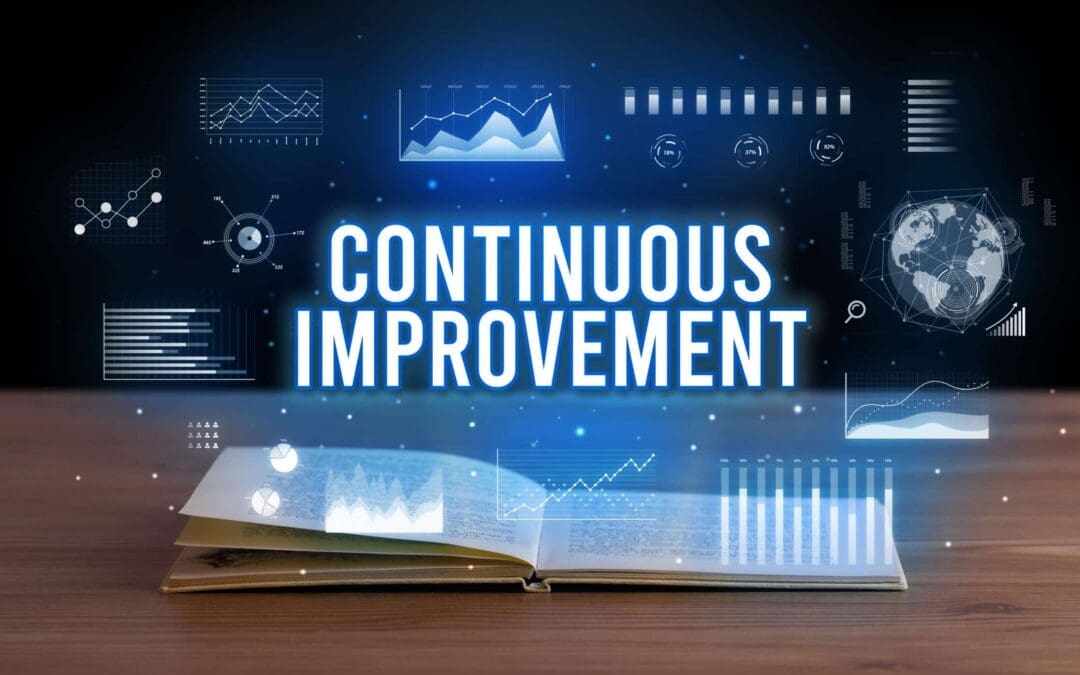Table of contents
The transformative power of continuous improvement!
In a world that is constantly evolving, embracing change and refining our processes is not just a choice, but a necessity. Whether you’re striving for personal growth, seeking to enhance your professional skills, or aiming to revolutionize your organization, the journey of continuous improvement is a universal path to excellence. Here, we explore the principles, strategies, and real-life stories that illuminate the way forward. Join us as we delve into the art of being a continuous quality or process improvement manager, unlocking its secrets and discovering how small, incremental changes can lead to significant, lasting progress in a job. Together, let’s embark on a journey of perpetual learning, innovation, and advancement, empowering ourselves and our communities to reach new heights of success.
What Is Continuous Improvement?
Continuous Improvement, often abbreviated as CI, is a systematic and ongoing effort to enhance products, services, or processes. Rooted in the philosophy of constantly striving for excellence, it involves making incremental changes and innovations to achieve efficiency, quality, and customer satisfaction. The core idea behind continuous improvement is to challenge the status quo and encourage a culture of learning and adaptation. It’s not about revolutionary, large-scale changes, but rather the accumulation of small, incremental improvements over time. By analyzing current practices, identifying areas for enhancement, and implementing changes, individuals, teams, and organizations can optimize their operations, reduce waste, and respond effectively to evolving challenges. CI methodologies, such as Lean, Six Sigma, and Kaizen, provide structured approaches to achieve these goals. Ultimately, continuous improvement is a mindset—an ongoing commitment to excellence and the pursuit of perfection, making it a fundamental driver of progress in various aspects of life and work.
Do we need a Continuous Improvement Department?
We post many questions to Social Media channels that fuel great discussions. The question of “Should a company have a Continuous Process and Quality Improvement Department/Manager” historically fuels great responses.
Here is the response:
Generally, the response to this question is: Continuous Improvement (CI) is a “process” rather than a department and there should not be a separate Continuous Improvement Department. The response below is aligned with this school of thought.
“I think of Continuous Improvement as a process rather than a department. It’s less about what department Continuous Improvement is in and more about how it’s led, staffed, and prioritized. Functional departments are supposed to provide us with advantages in skill development, reporting lines, and economies of task scope. This is mostly true for business fundamentals (recurring activities/outputs). But when it comes to the Continuous Improvement process, this is really a set of temporary activities that produce a unique output. To be successful at CI requires more of a project organizational structure that’s cross-functional. So, my preference would be for CI projects to be identified as part of company-wide strategic planning. Within that framework projects will be selected. A sponsor and change agents with the appropriate skills and authority will be assigned (members of the Quality Department). The Change Agents then select cross-functional team members.”

Our experience has taught us…
My colleagues and I have been a part of or led several Lean and/or Six Sigma implementations. Our experience has taught us: If there is not a manager of the Continuous Improvement efforts, they will not be sustained. CI is owned by everyone, and all have roles and responsibilities in the CI efforts. The following post by Forrest McCracken does an excellent job describing the role of a CI department:
All members of all departments should be trained in the concepts of CI. Managers and select employees should be trained to a higher level to implement CI efforts within their functional area. CI departments should train workers, track and report overall improvement goals and outcomes, and advise senior managers on CI strategy. They should also act as internal consultants to managers at all levels and help increase the efficiency and quality of internal and external providers of goods and services. Continuous Improvement cannot be solely operated by one department or job. CI is a culture and a skill set that must be learned through study and practice by those that it affects the most, namely the lowest-level managers and workers. Quality assurance departments should work with CI as a cross-functional team and help CI capture trends, validate CI efforts, and identify improvement opportunities when real data flags a real problem. Building a good CI program is not easy but building one that causes more harm than good is quite simple.
Structuring a continuous improvement program for a blog involves creating a systematic approach to enhance the blog’s content, user experience, and overall performance over time. Here’s a step-by-step guide to help you establish an effective continuous improvement program for your blog:
How to Structure a Continuous Improvement Program?
1. Set Clear Goals:
Define specific, measurable, achievable, relevant, and time-bound (SMART) goals for your blog. Identify areas like website traffic, user engagement, content quality, or reader satisfaction that you want to improve.
2. Data Collection and Analysis:
Use tools like Google Analytics to collect data on your blog’s performance. Analyze metrics such as page views, bounce rates, and user behavior to identify trends and areas for improvement. Conduct surveys or solicit feedback from readers to understand their preferences.
3. Identify Improvement Opportunities:
Based on the data analysis and feedback, pinpoint areas that need enhancement. This could include content quality, readability, website design, navigation, or social media engagement.
4. Generate Ideas for Improvement:
Brainstorm ideas and solutions to address the identified areas for improvement. Encourage your team members or collaborators to contribute their suggestions. Research industry best practices and successful blogs for inspiration.
5. Prioritize and Plan:
Prioritize the improvement ideas based on their potential impact and feasibility. Create a roadmap or action plan outlining specific tasks, deadlines, and responsible team members for each improvement initiative.
6. Implementation:
Implement the planned improvements systematically. This could involve rewriting and updating blog posts, redesigning the website layout, optimizing for SEO, enhancing user interactivity, or integrating multimedia elements.
7. Testing and Feedback:
Test the implemented changes to ensure they work as intended. Monitor the impact on your blog’s performance metrics. Additionally, gather feedback from users to gauge their response to the improvements.
8. Iterate and Repeat:
Based on the feedback and performance data, iterate on the implemented changes. Identify new areas for improvement and repeat the process. Continuous improvement is an iterative cycle, so be prepared to adapt and evolve your strategies as needed.
9. Celebrate Success and Learn from Failures:
Acknowledge and celebrate the successes achieved through the improvement initiatives. Equally important, analyze any failures or initiatives that didn’t yield the desired results. Extract lessons from both successes and failures to refine your continuous improvement strategies.
10. Promote a Culture of Continuous Improvement:
Encourage everyone involved in the blog, including writers, designers, and developers, to embrace a culture of continuous improvement. Foster an environment where feedback is valued, and everyone is empowered to contribute ideas for enhancing the blog.

What are your thoughts?
What are your thoughts? Should Continuous Improvement be managed as an entity working as internal consultants, teachers, and mentors to distribute Change Agents in all departments and jobs? Or should CI be a distributed role throughout the organization; not managed by one entity but managed by each of the functional groups or departments?













CI culture is always driven from the top. It cannot grow and sustain if 2-3 people at bottom line are hired to make substantial changes. Yes, there should be a CI department, but not an individual function but a function which will be doing cross-functional projects to achieve the management’s strategic goals.
Manik, Excellent Comment. CI should be in support of every functional area. They should help manage Change Agent’s in every functional area.
Job = Standard work + Improvement. That means “Improvement” is part of manager’s job. Why have a CI department?
My company recently transitioned from distributed to centralized CI and I think it was the right move for us. Our company is very large, and everyone is already busy with day-to-day demands. Having a group dedicated to continuous improvement has really helped to drive things forward. The dedicated CI folks can focus on project management and prioritization. The departmental managers play a supporting role and ensure that day-to-day activities keep going.
Scott,
Centralized CI can work only when there is buyin from stakeholders and a expectations have been communicated effectively. Even then, they tend to fail. Over time, most centralizecd CI groups end up as “the cops” of the organization. That never end well.
Now a eureopean comment, even I am actulaay in China doing a lean project. In my opinion and experience there is no need for a specific department, BUT somebody in the organisation , who repots LEAN activities to senior management needs to be installed for sure.
Gerhard
Continuous Improvement is a culture and not just a box full of tools and techniques. It is about behavioural change across the organisation with demonstrable commitment from senior management. It should be embraced as such and the notion of having a CI team negates the realisation of the objective. Further, a specialised CI team are seen as an imposition on the rest of the organisation and as such, resistance to change escalates rather quickly!
Boy am I glad I dont work for some of you. We have a dedicated department “Performance Improvement” with excellent facilitators (internal consultants) that assist departments on a daily basis. They train our organization in Lean, Six Sigma, Change Managment concepts and many soft skills (presenting your project A3, Gemba walk and talk etc) Many organizations like ours do not prioritize well and our PI team works with leaders to scope. Our PI team only works with areas that ask they never go in and tell departments hence they are never seen as the bad guys they are seen as needed and valued. This culture is driven from the top. Culture change is hard and our PI team is there assisting to drive organizational change toward continous improvement. So yes a dedicated team works in our organization.
Top management sponsorship + CI Experts governance + Functional Heads buy-in + Front-end people’s desire for improving current state = success
Yes there absolutely needs to be a separate body teaching the importance of improving processes at the process owner level and governing how this gets executed across the organisation to ensure there is a standard logic and transparency into what is happening. Equally important is that a platform is used to give this information to senior and middle managers in real time without having to disturb their staff.
Great comment. Unfortunately, this department has become a silo for policing processes (which will fail quickly) rather than a group of mentors used to propagate continuous improvement in the organization.
In an ideal world, you don’t need a CI department, CI is everyone’s job. But in reality, absolutely you need a well structured CI department to promote the culture, drive initiatives and support / guide other team’s efforts. I have never seen or heard of an organization that is mature enough to implement proper CI with a CI dedicated function.